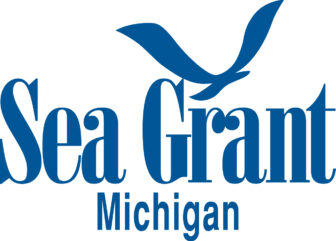
Michigan Sea Grant logo. Image: Michigan Sea Grant.
By Sydney Bowler
Capital News Service
Michigan Sea Grant recently announced four new research projects with one common goal — protecting the Great Lakes.
It committed almost $1 million to the projects, including $225,000 from the Department of Environment, Great Lakes and Energy. In addition, university research partners contributed over $500,000 in matching funds.
Their major topics are water use, walleye, invasive mussel larvae and harmful algae blooms.
Sea Grant research program manager Michael Fraker said the projects were chosen because they “address topics that were identified by stakeholders as current areas of interest and need in the Great Lakes.”
Sea Grant is a cooperative program of the University of Michigan, Michigan State University and the National Oceanic and Atmospheric Administration.
A research project led by Michigan Technological University professor Gordon Paterson and assisted by professors Jill Olin and Trista Vick-Majors will investigate how invasive mussel larvae contribute to the flow of nutrients and energy in Lake Huron, particularly Saginaw Bay.
“Zebra mussels and quagga mussels have been quite a problem throughout the Great Lakes. One thing to consider is that when they spawn in the spring through fall, they create a tremendous amount of biomass from the larval stage, known as veligers,” said Paterson. “One of the consistent questions across the Great Lakes basin has been what happens to these veligers?”
“This project has received very good feedback from colleagues around the Great Lakes Basin as well, including a letter from the Canadian federal government,” Paterson said. “We’re very excited that the project is relevant regionally, locall, and, in a way, even nationally and internationally.”
He said the first field excursion is planned for sometime around the last week of May and that the research team expects to find a high density of mussel larvae.
The project received just under $200,000.
The overarching goal of one project with MSU and the state is to help state residents collaboratively manage their water at a more local scale and meet communities’ water needs, said the project leader, professor Adam Zwickle.
A 2008 law allows local water consumers to create water user committees that would work with the Department of Environment, Great Lakes and Energy to make collaborative management decisions, develop shared water-use solutions that prevent or resolve water use conflicts and make water withdrawal requests.
However, Zwickle said no water user committees have formed in Michigan.
“Our job is to first, understand why people have not come together to form these water user committees and, second, create a guide that will help people make these groups to collaboratively manage water resources at a local level,” Zwickle said.
From his previous research and experiences, Zwickle said he learned that sustainable natural resource management most often is done best at the community level because “local people know the intricacies of their local landscape and resources.”
The committees will eventually form in areas where water resources are limited, he said.
The two-year project received $349,878.
Another project funded by Sea Grant and led by MSU professor Chris Vandergoot will explore where walleyes spawn in Saginaw Bay to ensure better management of the fishery and habitat protection.
“We are looking at the movement of walleye and trying to identify potential lake or bay spawning populations within Saginaw Bay,” he said.
There are known spawning populations of walleye in the western basin of Lake Erie, in Green Bay inlet of Lake Michigan and in the Tittabawassee River, a major tributary of Saginaw Bay.
His team will also try to determine whether the Lake Huron-Saginaw Bay system operates similar to these other areas.
The team will place acoustic tags on 355 walleye and place acoustic receivers in the mouth of each river leading into the bay and on reefs. That will give researchers access to the movement data from the tagged fish.
“If I were to tag a fish in Lake Erie and it were to swim up the Detroit River into Lake Huron, I would get those detections back even though I’m not maintaining those receivers,” Vandergoot said. “It works like a data warehouse for this detection data.”
According to a Department of Natural Resources report, the Saginaw Bay walleye fishery plateaued in the mid-1990s when the bay was heavily dominated by small prey fish species and there was insufficient predation to maintain ecological balance.
The DNR “took some preemptive measures, did some stocking and enacted some different regulations to help this population recover,” Vandergoot said. “Today, the population is at a very high abundance relative to the last several decades.”
“The study will help refine management objectives and help manage the population moving into the future by determining if there are actually any bay spawning populations,” he said.
This project received $235,000, with $80,000 of it from the Great Lakes Acoustic Telemetry Observation System, the DNR and other research partners.
The last project, led by UM professors Vincent Denef and Melissa Duhaime, will map genetic variation in microcystis, a genetically diverse species of microscopic organisms.
The core question to be answered in this project is how do genetic differences influence microcystis’ ability to survive predators in harmful algal blooms?
The project will focus on two predators: quagga mussels and a type of zooplankton.
Denef’s team will then map the genotypes of the population to determine resistance and vulnerability toward predation. Overall, the study will illuminate the effects of microcystis on the food web.